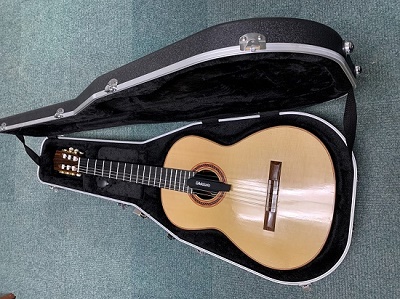Caring for your guitar
Your guitar is a big investment, taking care of it correctly just makes sense.
Store your classical guitar in its case when not in use
There are numerous reasons why storing your classical guitar in its case is the best way to keep your guitar in good condition. By far the two most important reasons are to avoid the guitar being damaged and to be able to control the humidity.. A guitar case is the best way to store your guitar from being knocked over. Whether that is through young children, animals or whatever it may be, accidents can, do, and will happen.
A guitar case is the best way to store your guitar from being knocked over. Whether that is through young children, animals or whatever it may be, accidents can, do, and will happen.
If you want to keep your guitar in good condition you should keep it in its case when it is not being played.
Protect your classical guitar from humidity fluctuations
Whether you live with high, low, or fluctuating humidity, it’s best to create a microclimate for your classical guitar. The best method is to store it in its case, with a good hygrometer so you can respond to humidity extremes quickly. There are very affordable ones on amazon.
You should be aiming for 45-55% humidity. Long periods below 45% or above 55%, are dangerous. Use a humidifier to keep the guitar in the 45-55 percent range. D'Addario Humidipak Automatic Humidity Control System is excellent and has my recommendation.
Keep your classical guitar out of direct sunlight
Direct sunlight for extended periods of time can damage a guitar. UV rays will cause premature fading and aging of the wood and any finish. Only keep a guitar in direct sunlight for 1 to 2 hours at any one time. The simplest way to keep your guitar out of direct sunlight is to keep your classical guitar in a hard case. The case will block the UV rays. Although it will heat up in direct sunlight, the heat around the guitar will be distributed and do less damage than if the guitar was in direct sun.
Keep your guitar away from quick temperature changes
Classical guitars are made of wood and can expand and contract with the temperature and humidity of different seasons. The issue comes when there is a rapid change in either. If you were to take a guitar out of a cold basement and then put it inside an enclosed car in the hot sun, and then start playing it, this could cause significant damage.
Ideally the guitar should be kept in its case away from any extreme temperature environments, hot, cold or otherwise. If it is taken from one temperature to another within a short period of time, it should be allowed to acclimatize inside the case for 10 to 15 minutes.
Clean and polish the top, sides, and back of your guitar
By creating a regular cleaning schedule, you can ensure your classical guitar will always be in good condition.
Some key points to remember when polishing your guitar are:
- Never used a wax-based product. The wax will build up over time and impede the top from vibrating.
- Never spray any product directly onto your guitar, rather apply to a cloth and then clean and polish.
- Don’t apply polish to the frets as the fretboard is untreated.
- If your guitar has a shellac finish (French polish), any alcohol-based cleaning product will damage the polish.
- Extended exposure to water can damage the finish. Sweat is mostly water and salts, therefore the sweat from your arm and chest overtime can make the finish look faded or cloudy. When practicing, use a forearm protector. It prevents the transfer of sweat to the top of the lower bout on the bass side of the guitar. A cheap option is to cut an old sock to use it as a forearm protector. There are commercial options as well. Also keep the guitar from full contact with your chest, especially in the summer when it is more likely for you to be sweating and wearing thinner clothes.
Cleaning and conditioning the fretboard
The fretboard of your guitar should be cleaned and conditioned once or twice a year. The best and obvious time to do this is at a point when you change your guitar strings. So, when you change strings after 6 to 12 months, then it is the time to clean the fretboard.
Most guitars have an untreated Ebony fretboard; therefore, no finish should be applied to the fingerboard. I recommend the application of mineral oil using a rag, letting it rest for 30 minutes, and then wiping it clean with another clean rag.
Traveling with your guitar
When travelling by plane with your guitar, and you are checking-in your guitar, you should have a travel guitar case. If you don’t have one (they can be expensive) you should pack the guitar in its case and then the case in a box. Do not check-in your standard guitar case without further protection. You should remove the tension on all the strings before closing the guitar case. If the guitar fits loosely in the case, add additional padding material to make sure the guitar does not bounce around when being handled as luggage.
Traveling by car gives you a lot more control, but you should be aware of things like temperature and humidity changes. Do not leave the guitar in the car trunk for a long period of time on a hot summer day as the high temperatures will possibly damage the guitar and its finish. If you are traveling from a very dry location to a humid one, or vice versa, allow the guitar to acclimatize to the new conditions before playing. Do this by opening the case just a crack for 15 to 20 minutes to let the guitar mold to the new conditions gradually.